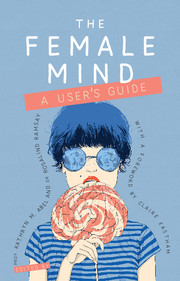Book contents
- Frontmatter
- Acknowledgements
- Contents
- Foreword
- Introduction: being female
- Part I Women in perspective
- Part II Women and society
- Part III Women and their environment
- 10 Emotional well-being and staying well
- 11 Sensitive motherhood
- 12 Religion and spirituality
- 13 Linking physical and mental health in women
- 14 Obesity
- 15 Women and sleep
- 16 Women and pain
- 17 Bereavement, loss and grief
- Part IV Women and specific disorders
- Part V Women and treatment
- Contributors
- Index
16 - Women and pain
from Part III - Women and their environment
Published online by Cambridge University Press: 02 January 2018
- Frontmatter
- Acknowledgements
- Contents
- Foreword
- Introduction: being female
- Part I Women in perspective
- Part II Women and society
- Part III Women and their environment
- 10 Emotional well-being and staying well
- 11 Sensitive motherhood
- 12 Religion and spirituality
- 13 Linking physical and mental health in women
- 14 Obesity
- 15 Women and sleep
- 16 Women and pain
- 17 Bereavement, loss and grief
- Part IV Women and specific disorders
- Part V Women and treatment
- Contributors
- Index
Summary
Imani's story
Imani is a 33-year-old medical secretary. She is a quiet, introverted person with no family and few friends, working in a department with a lot of stress. One day she had a minor injury to her knee. Surprisingly, she developed severe pain in her whole leg, with swelling and temperature and colour changes. Her general practitioner (GP) and doctors at the accident and emergency service (A'E) thought she was making up her symptoms, but she became increasingly disabled until, finally, she was unable to walk. A specialist in pain medicine assessed her, and diagnosed her with chronic regional pain syndrome. The doctor gave her medication to control the pain and she started a rehabilitation programme that made a big difference to how she was feeling. This allowed Imani to return to work, though some pain and colour changes returned from time to time.
Pain, especially acute pain, is often useful. It warns us that a part of our body is injured or at risk of being damaged. Without the experience of pain, we would not know to take our hand from the fire or attend to a broken leg. However, pain can also signal a false alarm. For example, headache, the most common pain, is not usually associated with any actual damage to the head or brain. Usually it is caused by spasms in the muscles around the head and neck. It is, however, important to attend to pain as a warning sign. Pain can be a physical or a psychological warning sign, and is most often a combination of both. Pain is well recognised to be more common in women, partly because of the fact that only women experience menstrual pain and pain during labour.
It is important to understand both the physical and the psychological aspects of pain. A lack of awareness of the psychological side leads patients and doctors to rely excessively on medication and other physical treatments such as injections or surgery. It is now well established that the overprescription of medication for pain can do more harm than good. Of course, the judicious prescription of medication and, in selected cases, injections or even surgery, can be helpful.
- Type
- Chapter
- Information
- The Female MindUser's Guide, pp. 98 - 103Publisher: Royal College of PsychiatristsPrint publication year: 2017



